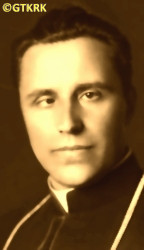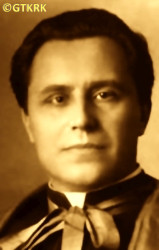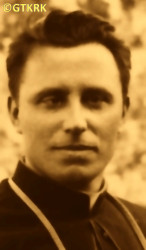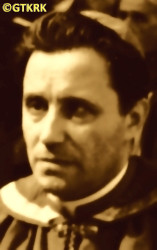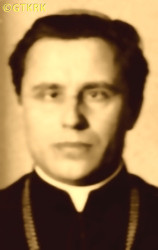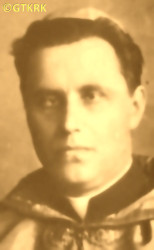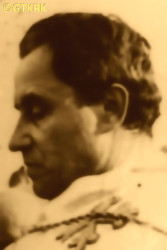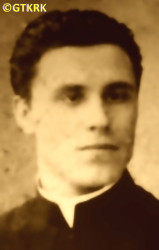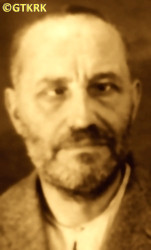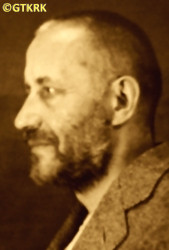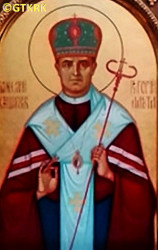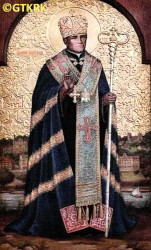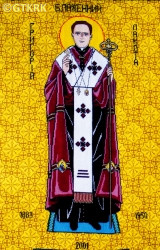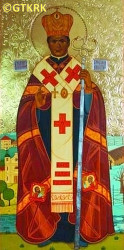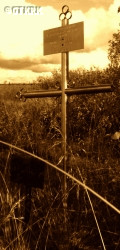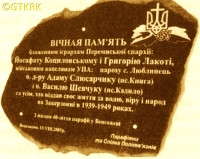Roman Catholic
St Sigismund parish
05-507 Słomczyn
85 Wiślana Str.
Konstancin deanery
Warsaw archdiocese, Poland
full list:
displayClick to display full list

searchClick to search full list by categories
wyświetlKliknij by wyświetlić pełną listę po polsku

szukajKliknij by przeszukać listę wg kategorii po polsku

Martyrology of the clergy — Poland
XX century (1914 – 1989)
personal data
religious status
blessed
surname
ŁAKOTA
forename(s)
Gregory (pl. Grzegorz)
beatification date
27.06.2001more on
www.swzygmunt.knc.pl
[access: 2013.05.19]

the RC Pope John Paul IImore on
en.wikipedia.org
[access: 2014.09.21]
function
bishop
creed
Ukrainian Greek Catholic GCmore on
en.wikipedia.org
[access: 2013.05.19]
diocese / province
Przemyśl GC eparchymore on
pl.wikipedia.org
[access: 2013.05.19]
academic distinctions
Doctor of Theology
honorary titles
Papal chamberlainmore on
Papal chamberlain
nationality
Ukrainian
date and place
of death
04.11.1950

ITL MinLagGuLAG slave labour camp network
today: Abez, Komi rep., Russia
more on
en.wikipedia.org
[access: 2022.01.09]
alt. dates and places
of death
05.11.1950, 12.11.1950, 06.11.1954
details of death
After German and Russian invasion of Poland in 09.1939 and start of the World War II, after fall of Poland remained in German–occupied part of his eparchy.
Ministered from Yaroslav.
After German attack on 22.06.1941 of their erstwhile ally, Russians, returned to Przemyśl.
After the end of military hostilities of the World War II, after German defeat and start in 1944 of another Russian occupation, after formal outlawing on 08‐10.03.1946 of Greek Catholic Church and incorporating its structures into Russian Orthodox church on the territories directly occupied by the Russian, e.g. in Ukraine, arrested on 28.06.1946 in Przemyśl (his superior, Bp Kocyłowski, was arrested a day earlier), by Commie‐Nazi UB, Polish unit of Russian MGB (successor of genocidal NKVD), led by a Russian MGB officer.
On the same day transported out to Lviv.
There, in Zboishchy district — where settled despite an order to move to nearby Vynnyki — on 25.07.1946 (or on 03.07.1946) arrested again, this time by the Russians.
Held in Lviv in on Łąckiego Str. prison.
Next on c. 14.08.1946 transported to Kiev where held in Lyukyanivska Str. prison.
Accused of „betrayal of the Ukrainian people, cooperation with Nazi Germany and espionage for the Vatican”, „heading of activities of anti–Russian Catholic Action organization”.
On 19‐21.02.1947 in Kiev tried by a criminal Russian kangaroo court „Troika MGB” and sentenced to 8 years of slave labour in Russian concentration camps Gulag.
From 01.10.1947 held in Bilychi (today one Kiev's districts).
From there transported to ITL VorkutLag where n. Vorkuta slaved in coal mines.
On 28.04.1950 taken to a camp's „hospital” in Abez village, in ITL MinLag concentration camp group.
There perished, suffering form lung and larynx tuberculosis.
cause of death
extermination
perpetrators
Russians
sites and events
AbezClick to display the description, ITL MinLagClick to display the description, ITL VorkutLagClick to display the description, GulagClick to display the description, Kiev (Lyukyanivska)Click to display the description, Lviv (Łąckiego)Click to display the description, Ribbentrop‐MolotovClick to display the description, Pius XI's encyclicalsClick to display the description
date and place
of birth
31.01.1883

Holodivkatoday: Zadnistrani, Rudky urban hrom., Sambir rai., Lviv obl., Ukraine
more on
uk.wikipedia.org
[access: 2022.08.05]
parents
ŁAKOTA John
🞲 ?, ? — 🕆 ?, ?

KAWALEC Euphrosyne
🞲 ?, ? — 🕆 ?, ?
presbyter (holy orders)
ordination
30.08.1908

Przemyśltoday: Przemyśl city pov., Subcarpathia voiv., Poland
more on
en.wikipedia.org
[access: 2021.04.01]
St Therese GC cathedral churchmore on
en.wikipedia.org
[access: 2025.03.14]
positions held
1926 – 1950
titular bishop — Daonium RC diocese — appointment: on 10.02.1926; ordination: on 16.05.1926, in the Birth of the John the Baptist cathedral in Przemyśl
1926 – 1950
auxiliary bishop (Lat. episcopus auxiliaris) — Przemyśl, Sambir and Sanok GK eparchy — appointment: on 10.02.1926
1925 – 1926
archpresbyter — Przemyśltoday: Przemyśl city pov., Subcarpathia voiv., Poland
more on
en.wikipedia.org
[access: 2021.04.01] ⋄ Cathedral Chapter ⋄ Nativity of St John the Baptist GC cathedral church
1924 – 1926
vicar general — Przemyśl GK eparchy
1918 – 1926
rector — Przemyśltoday: Przemyśl city pov., Subcarpathia voiv., Poland
more on
en.wikipedia.org
[access: 2021.04.01] ⋄ Greek Catholic Theological Seminary
from 1913
professor — Przemyśltoday: Przemyśl city pov., Subcarpathia voiv., Poland
more on
en.wikipedia.org
[access: 2021.04.01] ⋄ Greek Catholic Theological Seminary — lecturer in the history of the Church, canon law, homiletics and catechetics
till 1913
PhD student — Viennatoday: Vienna state, Austria
more on
en.wikipedia.org
[access: 2020.07.31] ⋄ theology, St Augustine Higher Scientific Institute for Diocesan Priests („Augustineum/Frintaneum”) — PhD thesis Germ. „Die Bedeutung derBergpredigt bei Matthäus” (Eng. „The meaning of Matthew's Sermon on the Mount”), public defense on 02.07.1913k
from c. 1910
secretary — Przemyśltoday: Przemyśl city pov., Subcarpathia voiv., Poland
more on
en.wikipedia.org
[access: 2021.04.01] ⋄ Eparchial Consistory (i.e. Curia) ⋄ Przemyśl GK eparchy — also: prefect of elementary schools
1908 – c. 1910
vicar — Trostyanetsvillage
today: non‐existent, Yavoriv urban hrom., Yavoriv rai., Lviv obl., Ukraine
more on
uk.wikipedia.org
[access: 2022.08.05] ⋄ Nativity of the Blessed Virgin Mary GC parish ⋄ Yavorivtoday: Yavoriv urban hrom., Yavoriv rai., Lviv obl., Ukraine
more on
en.wikipedia.org
[access: 2021.10.09] GC deanery
till 1908
student — Przemyśltoday: Przemyśl city pov., Subcarpathia voiv., Poland
more on
en.wikipedia.org
[access: 2021.04.01] ⋄ philosophy and theology, Greek Catholic Theological Seminary
from 1903
student — Lvivtoday: Lviv urban hrom., Lviv rai., Lviv obl., Ukraine
more on
en.wikipedia.org
[access: 2022.01.16] ⋄ Department of Theology, John Casimir University [i.e. clandestine John Casimir University (1941‐1944) / Ivan Franko University (1940‐1941) / John Casimir University (1919‐1939) / Franciscan University (1817‐1918)]
others related
in death
KOCYŁOWSKIClick to display biography Joseph (Bp Josaphat), RESZETYŁOClick to display biography Roman, KAJETANOWICZClick to display biography Dennis (Fr Roman), OLEŃSKIClick to display biography Peter (Fr Paul), OSADCAClick to display biography Michael, HRUSZKIEWICZClick to display biography Theodore, ŁOPACZAKClick to display biography Elias
sites and events
descriptions
Abez: Penal GUŁAG camp 274/17 „B” in a village Abez on Usa river, by the Pechorska train line (Kotlas—Vorkuta) in Russian Komi republic (beyond Arctic Circle) belonging to various complexes of slave labour concentration camps: ITL SevPechLag (1940‐1950), ITL IntaLag (1941‐1948), ITL MinLag (1948‐1957) and PechorLag (1950‐1959). Prisoners slaved at coal transport form Vorkuta mines, goods shipments, aforementioned railway line construction, including bridge over Usa river. It contained a „central hospital” for those camps, including totally exhausted inmates of ITL VorkutLag. (more on: zeslaniec.plClick to attempt to display webpage
[access: 2013.08.10], gulagmuseum.orgClick to attempt to display webpage
[access: 2014.11.14])
ITL MinLag: Russian Rus. Исправи́тельно‐Трудово́й Ла́герь (Eng. Corrective Labor Camp) ITL Rus. Минеральный (Eng. Mineral) — concentration and slave forced labor camp (within the Gulag complex) — headquartered in the town of Inta in the Republic of Komi. Founded on 02.28.1948 on the premises of ITL IntaLag camp, until 1954 functioning as the Rus. Особый лагерь (Eng. Special camp) GULAG No. 1. Prisoners slaved in an industrial complex managed by the Russian Ministry of Internal Affairs — in coal mines, gold and quartz mining, construction of new mines, construction of roads and buildings, drainage of land, repair and mechanical workshops, brick kilns, hollow brick factories, logging, etc. At its peak — till the death on 05.03.1953 of Russian socialist leader, Joseph Stalin — c. 35,000 prisoners were held there: e.g. 24,112 (01.01.1949); 28,371 (01.01.1950); 33,056 (01.01.1951); 34,448 (01.01.1952); 27,785 (01.01.1953); 28,055 (01.01.1954). Ceased to exist on 03.06.1957 and got incorporated into the ITL PechorLag camp. (more on: old.memo.ruClick to attempt to display webpage
[access: 2024.04.08], old.memo.ruClick to attempt to display webpage
[access: 2024.04.08])
ITL VorkutLag: Russian Rus. Исправи́тельно‐Трудово́й Ла́герь (Eng. Corrective Labor Camp) ITL Rus. Воркутинский (Eng. Vorkutinskiy) — concentration and slave forced labor camp (within the Gulag complex) — headquartered in the town of Vorkuta in the Republic of Komi (initially prob. in Arkhangelsk Oblast), beyond the Arctic circle. Founded on 10.05.1938. Prisoners slaved at the construction of mines and coal mining (including processing plants, construction and renovation of access railway lines), preparation for industrial purposes and development of molybdenum deposits (including construction of the Vorkuta‐Kharbey power line, experimental enrichment plant, access roads), construction of barges on the Pechora River, construction of a thermal power plant, in various factories (production of bricks, building materials, wood processing, cement, furs, consumer goods), workshops (repair, mechanical), auxiliary agricultural work, etc. At its peak — till the death on 05.03.1953 of Russian socialist leader, Joseph Stalin — c. 73,000 prisoners were held there: e.g. 52,195 (01.01.1946); 62,525 (01.01.1948); 62,676 (01.01.1950); 72,940 (01.01.1951); 41,677 (01.01.1952); 52,453 (01.01.1955); 50,515 (01.01.1956); 49,646 (01.01.1957). In the most tragic year in the history of the camp, 1943, 15.5% of prisoners died. The total number of victims is unknown. Ceased to exist in 1960. (more on: old.memo.ruClick to attempt to display webpage
[access: 2024.04.08])
Gulag: The acronym Gulag comes from the Rus. Главное управление исправительно‐трудовых лагерей и колоний (Eng. Main Board of Correctional Labor Camps). The network of Russian concentration camps for slave labor was formally established by the decision of the highest Russian authorities on 27.06.1929. Control was taken over by the OGPU, the predecessor of the genocidal NKVD (from 1934) and the MGB (from 1946). Individual gulags (camps) were often established in remote, sparsely populated areas, where industrial or transport facilities important for the Russian state were built. They were modeled on the first „great construction of communism”, the White Sea‐Baltic Canal (1931‐1932), and Naftali Frenkel, of Jewish origin, is considered the creator of the system of using forced slave labor within the Gulag. He went down in history as the author of the principle „We have to squeeze everything out of the prisoner in the first three months — then nothing is there for us”. He was to be the creator, according to Alexander Solzhenitsyn, of the so‐called „Boiler system”, i.e. the dependence of food rations on working out a certain percentage of the norm. The term ZEK — prisoner — i.e. Rus. заключенный‐каналоармец (Eng. canal soldier) — was coined in the ITL BelBaltLag managed by him, and was adopted to mean a prisoner in Russian slave labor camps. Up to 12 mln prisoners were held in Gulag camps at one time, i.e. c. 5% of Russia's population. In his book „The Gulag Archipelago”, Solzhenitsyn estimated that c. 60 mln people were killed in the Gulag until 1956. Formally dissolved on 20.01.1960. (more on: en.wikipedia.orgClick to attempt to display webpage
[access: 2024.04.08])
Kiev (Lyukyanivska): Russian political prison in Kiev, in the first half of 20th century run by the genocidal NKVD, informally referred to as prison No 1, formally as Investigative Prison No 13 (SIZO#13). It was founded in the early 19th century. In the 20th century, during the Soviet times, the prison church was transformed into another block of cells. During the reign of J. Stalin in Russia, more than 25,000 prisoners passed through it. (more on: en.wikipedia.orgClick to attempt to display webpage
[access: 2014.09.21])
Lviv (Łąckiego): Prison at Łącki Str. in Lviv. Founded in 1918‐1920 by Polish authorities, mainly for political prisoners. From 1935 used as investigative jail. After German and Russian invasion of Poland in 09.1939 and start of the World War II, after start of Russian occupation Russians — local branch of Russian genocidal NKVD organisation — held thousands of prisoners, mainly Poles and Ukrainians, in prison (then prison no 1). It was also a place of carrying out death sentences passed by Russian summary courts on Poles suspected of participation in Polish clandestine resistance activities. In 06.1941, after German attack on 22.06.1941 of their erstwhile ally, Russians, NKVD agents slaugher — during genocidal massacres of prisoners — c. 924 inmates. During German occupation that followed in 1941‐1944 the prison’s buildings held German Gestapo investigative jail. It was a place of executions. In 1944‐1991, after German defeat and start of another Russian occupation, the building were again used by NKVD (and it successor MVD) as investigative jail and also investigative department. (more on: pl.wikipedia.orgClick to attempt to display webpage
[access: 2014.10.31])
Ribbentrop‐Molotov: Genocidal Russian‐German alliance pact between Russian leader Joseph Stalin and German leader Adolf Hitler signed on 23.08.1939 in Moscow by respective foreign ministers, Mr. Vyacheslav Molotov for Russia and Joachim von Ribbentrop for Germany. The pact sanctioned and was the direct cause of joint Russian and German invasion of Poland and the outbreak of the World War II in 09.1939. In a political sense, the pact was an attempt to restore the status quo ante before 1914, with one exception, namely the „commercial” exchange of the so‐called „Kingdom of Poland”, which in 1914 was part of the Russian Empire, fore Eastern Galicia (today's western Ukraine), in 1914 belonging to the Austro‐Hungarian Empire. Galicia, including Lviv, was to be taken over by the Russians, the „Kingdom of Poland” — under the name of the General Governorate — Germany. The resultant „war was one of the greatest calamities and dramas of humanity in history, for two atheistic and anti‐Christian ideologies — national and international socialism — rejected God and His fifth Decalogue commandment: Thou shall not kill!” (Abp Stanislav Gądecki, 01.09.2019). The decisions taken — backed up by the betrayal of the formal allies of Poland, France and Germany, which on 12.09.1939, at a joint conference in Abbeville, decided not to provide aid to attacked Poland and not to take military action against Germany (a clear breach of treaty obligations with Poland) — were on 28.09.1939 slightly altered and made more precise when a treaty on „German‐Russian boundaries and friendship” was agreed by the same murderous signatories. One of its findings was establishment of spheres of influence in Central and Eastern Europe and in consequence IV partition of Poland. In one of its secret annexes agreed, that: „the Signatories will not tolerate on its respective territories any Polish propaganda that affects the territory of the other Side. On their respective territories they will suppress all such propaganda and inform each other of the measures taken to accomplish it”. The agreements resulted in a series of meeting between two genocidal organization representing both sides — German Gestapo and Russian NKVD when coordination of efforts to exterminate Polish intelligentsia and Polish leading classes (in Germany called «Intelligenzaktion», in Russia took the form of Katyń massacres) where discussed. Resulted in deaths of hundreds of thousands of Polish intelligentsia, including thousands of priests presented here, and tens of millions of ordinary people,. The results of this Russian‐German pact lasted till 1989 and are still in evidence even today. (more on: en.wikipedia.orgClick to attempt to display webpage
[access: 2015.09.30])
Pius XI's encyclicals: Facing the creation of two totalitarian systems in Europe, which seemed to compete with each other, though there were more similarities than contradictions between them, Pope Pius XI issued in 03.1937 (within 5 days) two encyclicals. In the „Mit brennender Sorge” (Eng. „With Burning Concern”) published on 14.03.1938, condemned the national socialism prevailing in Germany. The Pope wrote: „Whoever, following the old Germanic‐pre‐Christian beliefs, puts various impersonal fate in the place of a personal God, denies the wisdom of God and Providence […], whoever exalts earthly values: race or nation, or state, or state system, representatives of state power or other fundamental values of human society, […] and makes them the highest standard of all values, including religious ones, and idolizes them, this one […] is far from true faith in God and from a worldview corresponding to such faith”. On 19.03.1937, published „Divini Redemptoris” (Eng. „Divine Redeemer”), in which criticized Russian communism, dialectical materialism and the class struggle theory. The Pope wrote: „Communism deprives man of freedom, and therefore the spiritual basis of all life norms. It deprives the human person of all his dignity and any moral support with which he could resist the onslaught of blind passions […] This is the new gospel that Bolshevik and godless communism preaches as a message of salvation and redemption of humanity”… Pius XI demanded that the established human law be subjected to the natural law of God , recommended the implementation of the ideal of a Christian state and society, and called on Catholics to resist. Two years later, National Socialist Germany and Communist Russia came together and started World War II. (more on: www.vatican.vaClick to attempt to display webpage
[access: 2023.05.28], www.vatican.vaClick to attempt to display webpage
[access: 2023.05.28])
sources
personal:
www.swzygmunt.knc.plClick to attempt to display webpage
[access: 2013.05.19], pl.wikipedia.orgClick to attempt to display webpage
[access: 2013.05.19]
bibliographical:
„Clergy of Przemyśl Eparchy and Apostolic Exarchate of Lemkivshchyna”, Bogdan Prach, Ukrainian Catholic University Publishing House, Lviv 2015
original images:
commons.wikimedia.orgClick to attempt to display webpage
[access: 2019.12.29], uk.wikipedia.orgClick to attempt to display webpage
[access: 2019.12.29], audiovis.nac.gov.plClick to attempt to display webpage
[access: 2019.12.29], audiovis.nac.gov.plClick to attempt to display webpage
[access: 2019.12.29], audiovis.nac.gov.plClick to attempt to display webpage
[access: 2019.12.29], commons.wikimedia.orgClick to attempt to display webpage
[access: 2019.12.29], photo-lviv.in.uaClick to attempt to display webpage
[access: 2019.12.29], photo-lviv.in.uaClick to attempt to display webpage
[access: 2019.12.29], pl.m.wikipedia.orgClick to attempt to display webpage
[access: 2019.12.29], pl.m.wikipedia.orgClick to attempt to display webpage
[access: 2019.12.29], photo-lviv.in.uaClick to attempt to display webpage
[access: 2019.12.29], sofija-net.plClick to attempt to display webpage
[access: 2019.12.29], blazejowskyj.comClick to attempt to display webpage
[access: 2019.12.26], katekhytyka-3.blogspot.comClick to attempt to display webpage
[access: 2019.12.29], gulagmuseum.orgClick to attempt to display webpage
[access: 2014.11.14], www.vox-populi.com.uaClick to attempt to display webpage
[access: 2020.01.26]
LETTER to CUSTODIAN/ADMINISTRATOR
If you have an Email client on your communicator/computer — such as Mozilla Thunderbird, Windows Mail or Microsoft Outlook, described at WikipediaPatrz:
en.wikipedia.org, among others — try the link below, please:
LETTER to CUSTODIAN/ADMINISTRATORClick and try to call your own Email client
If however you do not run such a client or the above link is not active please send an email to the Custodian/Administrator using your account — in your customary email/correspondence engine — at the following address:

giving the following as the subject:
MARTYROLOGY: ŁAKOTA Gregory
To return to the biography press below:
 Click to return to biography
Click to return to biography








